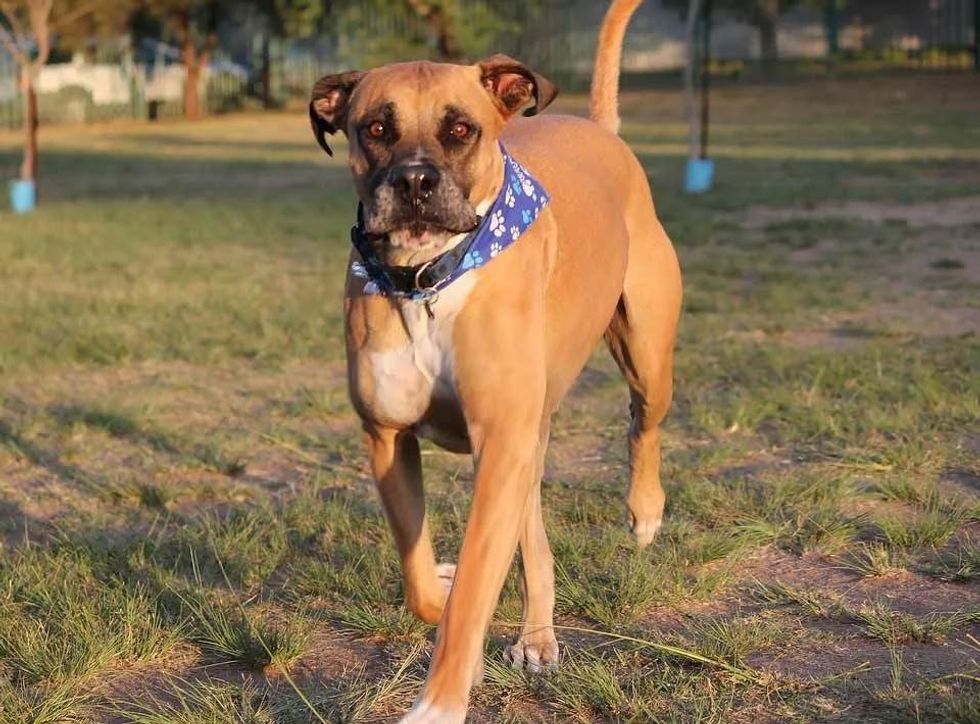Bullmastiffs are a mixed breed containing 40% of bulldogs and 60% of mastiffs that were bred in England. They have a black nose and dark hazel eyes. They have V-shaped ears that hang downwards.
They have a powerfully built body which makes them look very muscular. They were kept as guard dogs by the diamond mine owners in South Africa as they needed a dog that was muscular enough to bring the thieves down on the ground as well as keep them away.
Bullmastiffs not only helped them to guard the mines from thieves but also poachers.
Bullmastiffs were recognized by the American Kennel Club as a breed in 1924. They rank in the top 60 of the most popular list of breeds provided by the American Kennel Club.
They are big-sized dogs that have a very docile nature which makes them quite submissive in front of their human family. They are protective of the people they live with and are known to be family-friendly dogs.
They have a usual liking for babies. However, they are not very friendly with fellow dogs and become very aggressive around them, especially when it is a male dog.
The training of this dog breed should start right from their infancy, as that makes them habitual to taking instruction from their human, this breed is known to be on the adamant side and it should not be entertained else they grow habitual. The average life span of this loving animal is 8-10 years.
Bullmastiffs can manage solitude pretty well unlike other breeds which miss their humans too much. Bullmastiffs actually love being solitary.
Bullmastiffs surrender to authority and hence the best time to establish your authority is when they are puppies, which is also is the best time to start their training. Bullmastiffs are an intelligent breed but they still need consistent training in order to understand what their human is trying to say.
Being an intelligent breed, they very quickly grasp and understand the hand gestures you make, making it an easy breed to train.
Keep on learning about the Bullmastiff and facts which include Bullmastiff puppy facts, and Bullmastiff breed facts. If you like these Bullmastiff facts, then check out the pitbull chihuahua mix and the beagle lab mix.
Bullmastiff Interesting Facts
What type of animal is a Bullmastiff?
Bullmastiffs is a pet dog that is known to be aggressive yet very loyal to its human parent.
What class of animal does a Bullmastiff belong to?
Bullmastiffs come under the class of Mammalia.
How many Bullmastiffs are there in the world?
Although there isn't a specific study related to the population of bullmastiffs, still they're a commonly found breed in Europe and South Africa. Originally obtained from England, they were used as guard dogs by the Englishmen to protect them from poachers.
Where does a Bullmastiff live?
Bullmastiffs are a family dog, rather than a lovely family companion, yet they can be found in police service as a sniffing dog as well as guard dogs which roots in their origin back in England.
What is a Bullmastiff's habitat?
Bullmastiffs are a breed that cannot bear extreme weather conditions like scorching heat or cold winters. Although being a big-sized breed, they don't really require a large amount of space, it can fit in both an apartment and a house.
Who do Bullmastiffs live with?
Bullmastiffs are a loving breed that is ideal for a household and because of their courageous behavior the breed is favored by the security industry as well. Given their inclination to be independent, when it comes to being solitary Bullmastiffs can be left alone for long hours without any hesitation as they like their own space.
How long does a Bullmastiff live?
Despite the common health conditions the breed faces, Bullmastiff's life expectancy can vary from eight to ten years. They don't have a long life expectancy yet their energy level is unbeatable.
How do they reproduce?
As bullmastiff is not a long-lived breed, it gets a shorter period of reproductive time as compared to the other breed of dogs. They hit their reproductive maturity after 18 to 20 months, after which they need to be carefully bred keeping in mind the genetic problems they might be carrying from their ancestors.
What is their conservation status?
The conservation status is not listed for bullmastiff as there is no specific study on the conservation status related to this guard dog breed.
The popularity of this breed is increasing with time and it is no hidden fact the number of appearances this breed has made in showbiz, right from being Rocky in 'Little People, Big World' to Pete in 'Homeward Bound II: Lost In San Franciso'.
Bullmastiff Fun Facts
What do Bullmastiffs look like?

These solid build dogs are large in size with quite a short muzzle. Their body not only looks well built but also muscular.
And the coat appears to be in dark brindle, red, or fawn. Sometimes they have a mixture of such colors where they have a coat that is fawn and have stripped brindles. They have V shaped ears that are downward facing.
How cute are they?
Bullmastiffs are really cute-looking dogs despite their muscular build. They are big-sized dogs with a well-built body which makes them look elegant and sophisticated.
How do they communicate?
Usually, a Bullmastiff will communicate with different series of whines, barks, snorts, and grumbles. And interestingly they sigh just like humans when they are tired. A Bullmastiff might just talk back right away to its human parent.
How big is a Bullmastiff?
When it comes to male Bullmastiffs, their height varies from 25 to 27 in and they weigh around 110 to 130 lb whereas a female Bullmastiff's height varies from 24 to 26 in and they weigh around 99 to 119 lb. Even though Bullmastiff is a crossbreed of Mastiffs and Bulldogs, it still isn't as big as a Mastiff.
A Mastiff is 30 inches tall.
How fast can a Bullmastiff run?
Bullmastiffs are brachycephalic which is having the shape of the skull shorter than typical for its species eventually making the breed prone to heat exhaustion. Bullmastiffs are said to prefer leisurely walks as compared to jogging or running sessions.
With all the weight pounding on their joints, a Bullmastiff will end up damaging their joints and the massive built overheats their body over an elongated period of exercise.
How much does a Bullmastiff weigh?
A male Bullmastiff will weigh around 110 to 130 lb whereas a female Bullmastiff will weigh around 99 to 119 lb.
What are their male and female names of the species?
This species is just referred to as male Bullmastiff and female Bullmastiff as there are no specific names given to the genders of this powerfully built species.
What would you call a baby Bullmastiff?
Like every other dog, a baby bullmastiff is called a puppy although a human parent can always come with their unique names for their lovely Bullmastiff puppies.
What do they eat?
An adult Bullmastiff requires a large meal of quality dog food and the quantity depends upon the size, activity level, and weight of the dog. This breed prefers few but large meals twice a day. They can be fed once in the morning and once in the evening.
Are they slobbery?
Although bullmastiffs are a clean breed when it comes to their coats as they do not shed their fur that much, Bullmastiffs are big-time slobberers. So the time saved from cleaning their fur would be spent cleaning their saliva.
Would they make a good pet?
Right from being a puppy to a full-grown adult, a bullmastiff makes a lovely pet dog as they are very calm and have a very easy-going nature when it comes to dealing with families, although these dogs get suspicious when a new person enters their human parent's house but once they become familiar they love to play around.
A bullmastiff is a loyal family-oriented companion with a few territorial issues as they really don't appreciate the idea of any other animal apart from themselves.
They especially hate the other male breed of dogs which makes them a bit agitated but generally, they make for a lovely pet.
Did you know...
Bullmastiffs are gentle companions who are courageous protectors for their human family. Although this breed is cooperative still they have an adamant side that should not be entertained because it is difficult to reverse. Even though they are calm and mild dogs, they can get aggressive towards other dogs especially the male ones.
They become mature around 18 months, and they are often referred to as gentle giants of the canine world. They are fearless and courageous if provoked, otherwise they are fun, loving companions. They rank 51 of 197 on the American Kennel Club breed popularity ranking.
Though some dogs are sedentary and others are active when it comes to exercising, a moderate regime should be followed by the human parent for the good health of their bullmastiff. Bullmastiffs are an agile, obedient breed yet their ability to be courageous makes them an excellent guard dog.
Even though this breed is known to keep the intruders away, it is not known for its bite. They are inclined towards growling or barking, but when they bite they can be quite destructive. Because of this, they were also called the 'gamekeeper's night dog'.
Characteristics and health issues
This dog is prone to many common health conditions like hip and elbow dysplasia (a problem where the elbow joints do not join and have joint laxity), Aortic stenosis ( due to this problem the heart works double the rate it should pump blood and the dog becomes lethargic), Hypothyroidism (the growth of the dog gets affected as the glands do not work properly), Entropion (the eyelids roll inwards injuring the eyeball), skin allergies (this dog is known to be on antibiotics for its entire life to keep the skin allergies and other allergies at bay as the dog has very sensitive skin).
There is a wrong impression about Bullmastiff's temperament being on the aggressive side; Bullmastiffs are actually docile, reliable, loving, and loyal companions.
Getting your own Bullmastiff
If one is thinking of adopting their first pet, Bullmastiffs actually can be the perfect choice as they are not only docile but also elegant looking dogs with great reliability and courageous behavior which makes them a favorable choice over the others. A bullmastiff costs $1000 to $2200.
Here at Kidadl, we have carefully created lots of interesting family-friendly animal facts for everyone to discover! Learn more about some other mammals including the pocket pitbull and the cheagle.
You can even occupy yourself at home by drawing one on our Bullmastiff coloring pages.









